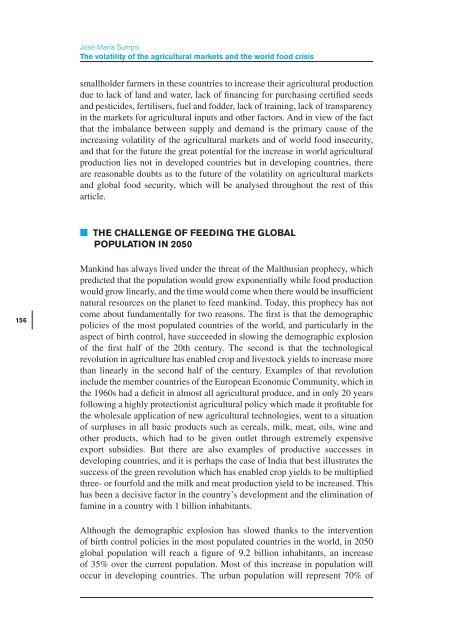Food security and global security - IEEE
Food security and global security - IEEE
Food security and global security - IEEE
- No tags were found...
Create successful ePaper yourself
Turn your PDF publications into a flip-book with our unique Google optimized e-Paper software.
José María SumpsiThe volatility of the agricultural markets <strong>and</strong> the world food crisissmallholder farmers in these countries to increase their agricultural productiondue to lack of l<strong>and</strong> <strong>and</strong> water, lack of financing for purchasing certified seeds<strong>and</strong> pesticides, fertilisers, fuel <strong>and</strong> fodder, lack of training, lack of transparencyin the markets for agricultural inputs <strong>and</strong> other factors. And in view of the factthat the imbalance between supply <strong>and</strong> dem<strong>and</strong> is the primary cause of theincreasing volatility of the agricultural markets <strong>and</strong> of world food in<strong>security</strong>,<strong>and</strong> that for the future the great potential for the increase in world agriculturalproduction lies not in developed countries but in developing countries, thereare reasonable doubts as to the future of the volatility on agricultural markets<strong>and</strong> <strong>global</strong> food <strong>security</strong>, which will be analysed throughout the rest of thisarticle.■■THE CHALLENGE OF FEEDING THE GLOBALPOPULATION IN 2050156Mankind has always lived under the threat of the Malthusian prophecy, whichpredicted that the population would grow exponentially while food productionwould grow linearly, <strong>and</strong> the time would come when there would be insufficientnatural resources on the planet to feed mankind. Today, this prophecy has notcome about fundamentally for two reasons. The first is that the demographicpolicies of the most populated countries of the world, <strong>and</strong> particularly in theaspect of birth control, have succeeded in slowing the demographic explosionof the first half of the 20th century. The second is that the technologicalrevolution in agriculture has enabled crop <strong>and</strong> livestock yields to increase morethan linearly in the second half of the century. Examples of that revolutioninclude the member countries of the European Economic Community, which inthe 1960s had a deficit in almost all agricultural produce, <strong>and</strong> in only 20 yearsfollowing a highly protectionist agricultural policy which made it profitable forthe wholesale application of new agricultural technologies, went to a situationof surpluses in all basic products such as cereals, milk, meat, oils, wine <strong>and</strong>other products, which had to be given outlet through extremely expensiveexport subsidies. But there are also examples of productive successes indeveloping countries, <strong>and</strong> it is perhaps the case of India that best illustrates thesuccess of the green revolution which has enabled crop yields to be multipliedthree- or fourfold <strong>and</strong> the milk <strong>and</strong> meat production yield to be increased. Thishas been a decisive factor in the country’s development <strong>and</strong> the elimination offamine in a country with 1 billion inhabitants.Although the demographic explosion has slowed thanks to the interventionof birth control policies in the most populated countries in the world, in 2050<strong>global</strong> population will reach a figure of 9.2 billion inhabitants, an increaseof 35% over the current population. Most of this increase in population willoccur in developing countries. The urban population will represent 70% of
















